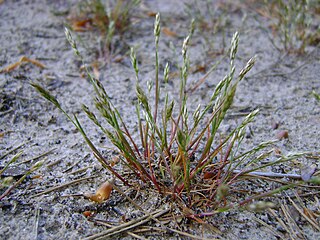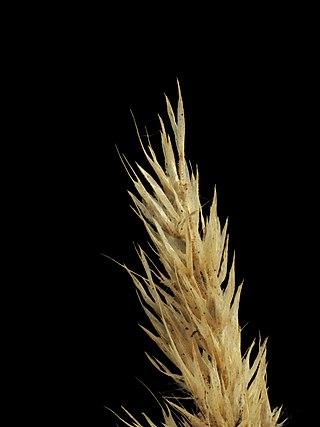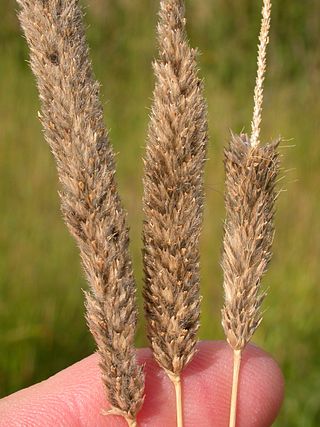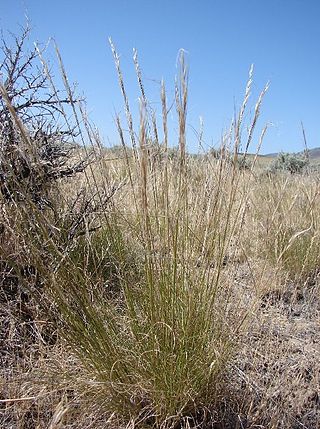
Timothy is an abundant perennial grass native to most of Europe except for the Mediterranean region. It is also known as timothy-grass, meadow cat's-tail or common cat's tail. It is a member of the genus Phleum, consisting of about 15 species of annual and perennial grasses.

Alopecurus pratensis, known as the meadow foxtail or the field meadow foxtail, is a perennial grass belonging to the grass family (Poaceae). It is native to Europe and Asia.

Alopecurus, or foxtail grass, is a common and widespread genus of plants in the grass family. It is common across temperate and subtropical parts of Eurasia, northern Africa, and the Americas, as well as naturalized in Australia and on various islands.

Asphodelus fistulosus is a species of plant known as hollow-stemmed asphodel, onionweed, onion-leafed asphodel, and pink asphodel. It is native to the Mediterranean region. It is an invasive exotic weed in the United States, with significant infestations in California, Arizona, New Mexico, and Texas. It is listed as a Federal Noxious Weed by the United States Department of Agriculture. It is also a common weed in parts of Australia, New Zealand, and Mexico, and it thrives in any area with a Mediterranean climate.

Alopecurus myosuroides is an annual grass, native to Eurasia, found in moist meadows, deciduous forests, and on cultivated and waste land. It is also known as slender meadow foxtail, black-grass, twitch grass, and black twitch.
British NVC community MG4 is one of the mesotrophic grassland communities in the British National Vegetation Classification system. It is one of four such communities associated with well-drained permanent pastures and meadows.

Aira praecox is a species of grass known by several common names, including early hair-grass, yellow hairgrass and spike hairgrass. It is native to Europe, where it is found in dry, sandy places, on rocky outcrops, and in heath grassland. It also grows in North America as an introduced species, where it can be found on the east and west coasts in sandy or rocky areas, such as beaches and roadsides. This is a tuft-forming annual grass growing up to about 10 to 15 centimeters in maximum height. The thin, narrow leaves are located at the base of the stem, and are typically 0.3–2 millimeters wide. It bears small, tightly congested inflorescences of purple-tinted green bisexual spikelets.

Alopecurus aequalis is a common species of grass known as shortawn foxtail or orange foxtail. It is native to much of the temperate Northern Hemisphere from Eurasia to North America. It is most commonly found in areas near fresh water, such as the margins of ponds and ditches.

Alopecurus geniculatus is a species of grass known by the common name water foxtail or marsh foxtail. It is native to much of Eurasia and introduced into North America, South America, and Australia. It grows in moist areas.

Alopecurus saccatus is a species of grass known by the common name Pacific foxtail, or Pacific meadow foxtail.

Chloris virgata is a species of grass known by the common names feather fingergrassfeathery Rhodes-grass and feather windmill grass.

Sporobolus alopecuroides is a species of grass known by the common name foxtail pricklegrass. It is native to Europe, the Middle East, and North Africa. It is also known in the western United States as a common and widespread introduced species, especially in sandy areas around water, such as lakesides. It has also been collected at shipping points near Philadelphia but has not been seen there in about a century. This is an annual grass producing mostly upright and unbranching stems, often dark in color, up to about 75 centimeters in maximum height. The green leaves are up to 12 centimeters long, sometimes waxy in texture. The inflorescence is a dense cylindrical panicle of tiny green to purple spikelets.

Cynosurus echinatus is a species of grass known by the common names bristly dogstail grass, rough dog's-tail and hedgehog dogtail. It is native to southern Europe, and it is known in the Americas and Australia as an introduced species and sometimes a noxious weed. An herbicide-resistant strain can be found growing as a weed in canola and wheat fields in Chile. This is an annual grass growing 10 to 50 centimeters tall. The inflorescence is a rounded or oval cluster or series of clusters of spikelets. The fertile spikelet has an awn up to a centimeter long. The awns clumped closely together into a tuft gives the inflorescence its bristly, hairy appearance.
Hordeum intercedens is a diploid, annual species of wild barley known by the common names bobtail barley and vernal barley. It is native to southern California and northern Baja California, where it is an increasingly rare member of the flora in saline and alkaline soils near seasonal waterflows and vernal pool habitats. Today most occurrences are located on the Channel Islands of California; many of the occurrences known from the mainland have been extirpated in the process of land development. This is an annual grass growing erect to bent in small tufts with stems up to 40 centimeters long. The inflorescence is a green spike up to 6.5 centimeters long made up of awned spikelets between 1 and 2 centimeters long.

Muhlenbergia andina, known by the common name foxtail muhly, is a species of grass.

Alopecurus arundinaceus, the creeping meadow foxtail or creeping foxtail, is a rhizomatous perennial species in the Grass family (Poaceae). Native to Eurasia and northern Africa, and widely introduced elsewhere, this sod forming grass is useful as a forage and for erosion control. It flowers between April and July, depending on its location. It grows in damp or saline grasslands and banks of waterways, and on mountains up to 1,200 m. However, according to the United States Bureau of Plant, Alopecurus arundinaceus was found at elevations up to 8500-9500 feet.

Setaria verticillata is a species of grass known by the common names hooked bristlegrass, rough bristle-grass and bristly foxtail. It is native to Europe, but it is known on most continents as an introduced species and often a noxious weed. It is a hardy bunchgrass which grows in many types of urban, cultivated, and disturbed habitat. It is a weed of many types of agricultural crops, growing in vineyards and fields. Herbicide-resistant strains have been noted.

Setaria viridis is a species of grass known by many common names, including green foxtail, green bristlegrass, and wild foxtail millet. It is sometimes considered a subspecies of Setaria italica. It is native to Eurasia, but it is known on most continents as an introduced species and is closely related to Setaria faberi, a noxious weed. It is a hardy grass which grows in many types of urban, cultivated, and disturbed habitat, including vacant lots, sidewalks, railroads, lawns, and at the margins of fields. It is the wild antecedent of the crop foxtail millet.

Eriocoma thurberiana is a species of grass known by the common name Thurber's needlegrass. It is native to the western United States, where it occurs from Washington to California and east to Montana and Wyoming.
Alopecurus creticus, the Cretan meadow foxtail, is a species of foxtail grass.

















